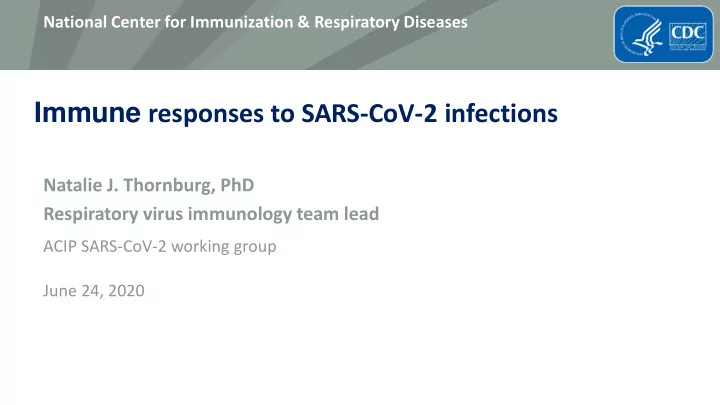

National Center for Immunization & Respiratory Diseases Immune responses to SARS-CoV-2 infections Natalie J. Thornburg, PhD Respiratory virus immunology team lead ACIP SARS-CoV-2 working group June 24, 2020
Outline 1. What do we know about immunity to coronaviruses in general? 2. What do we know, so far about SARS-CoV-2 immunity? 3. How do we test for immune responses? 4. Updates on severity of disease vs. antibody response and antibody kinetics 5. Conclusions
Coronaviruses Common coronaviruses Uncommon coronaviruses 229E SARS-1 NL63 MERS OC43 HKU1
What do we know about protective immune responses in common CoV infections? • In common CoV infections, protection is transient. Waning serum antibody contributes to susceptibility to reinfection. • 229E Human challenge model (Callow et al, Epidemiol Infect., 1990) – 15 volunteers were inoculated with HCoV-229E. – 10 with lower antibody titers became infected; 8 developed colds. – On re-challenge a year later, 9 became re-infected (virus shedding) but none developed a cold • Household respiratory virus infection study (Kiyuka et al, JID, 2018) – 2.5% NL63+ – Most household subjects had one infection in 6 month study – Repeat infections with NL-63, OC43, and 229E detected in 21, 5.7, and 4.0% respectively; >90 days apart – A minority of repeat infections exhibiting higher viral titers on second infection (41% NL-63, 31% OC43, and 1% 229E)
Does SARS-CoV-2 immunity resemble common coronavirus immunity?
Knowns – Most COVID-19 patients mount IgG and IgM responses to the virus – Many CoVID-19 patients mount neutralizing antibody responses – Magnitude of antibody response correlates to disease severity
Unknowns – Are COVID-19 patients susceptible to reinfection? Are antibodies a correlate of immunity? – – If so, what quality (Isotype, antigenic region, neutralizing)? – Is there a threshold of protection? – How long will serum antibodies last?
Assays to detect antibodies that bind SARS-CoV-2 Antigens – Spike – Target for neutralizing antibodies • RBD • S1 • Ectodomain (S2P) – Nucleocapsid – Abundant during viral replication Secondary antibodies – Pan Ig, IgG, IgM, IgA
Spike is highly glycosylated trimeric, class I fusion protein – metastable prefusion conformation Wrapp et. Al, Science 13 Mar 2020
Three different forms of spikes used in most ELISAs: antibodies to all three might contribute to neutralization Receptor binding RBD S1 N terminal One protomer domain of ectodomain or S2P S2 Fusion peptide Wrapp et. Al, Science 13 Mar 2020
Residue 614 is located at the S1 / S2 interface https://virological.org/t/whole-genome- sequence-of-the-severe-acute- respiratory-syndrome-coronavirus-2- sars-cov-2-obtained-from-a-south- african-coronavirus-disease-2019- covid-19-patient/452
Nucleocapsid protein ELISA PROS • Easy to produce large quantities of protein • Abundantly expressed during early infection • Used to identify immunity from natural infection vs. vaccine-induced immunity CON • Unlikely a target for neutralizing antibodies
zyxwvutsrqponmlkjihgfedcbaZYXWVUTSRQPONMLKJIHGFEDCBA ELISA and CMIA assays with FDA EUA authorization Manufacturer Isotype Antigen % Positive Agreement (n) Negative Agreement (%) 42.3-48.2; NCI panel 90 Euroimmune IgG S1 98.6-100 (1756) (597; 110) Roche Diagnostics pan Ig N 77 (209) 99.81 (5252) Bio-Rad pan Ig N 92.2 (51) 99.60 (687) Abbott Laboratories IgG N 95 (122) 95 (1070) DiaSorin, Inc IgG S1/S2 72.5 (135) 99.3 (1090) Ortho Clinical IgG S 87.5 (48) 100 (470) Ortho Clinical IgM, IgG S 83 (36) 100 (400) InBios IgG S 97.8(44) 99.0 (95) Siemens Pan Ig S 100(47) 99.8 (1586) Vibrant S and N 98.1 (53) 98.6 (501) Current as of 6/19/2020
Several different types of virus inhibition assays – with differing sensitivities, time to results, throughput, and need for containment lab Assay Plaque reduction neutralization titer Clinical isolate microneutralization Infectious clone reporter microneutralization Focus reduction assay Psuedovirus
More severe patients exhibit more robust and faster antibody responses To et al. The Lancet. 20: 565-574
A majority of hospitalized COVID-19 patients develop neutralizing antibody responses Suthar et al. Cell Reports Medicine. 2020 Jun 8
Thirty percent of patients with mild infection have low neutralizing antibody titers at hospital discharge https://www.medrxiv.org/content/10.1101/2020.03.30.20047365v2.full.pdf+html
Older patients had higher neutralizing antibody titers https://www.medrxiv.org/content/10.1101/2020.03.30.20047365v2.full.pdf+html
Most of what we know about SARS-CoV-2 immunology are from hospitalized patients. What about milder infections?
41% of antibody-positive USS TR sailors did not have detectable neutralization titers (IC100) Payne et al. MMWR. 69: 714-721
Serum antibodies drop between acute phase and 8-weeks post discharge Long et al. Nature Medicine. 18 JUN 2020
Conclusions Most SARS-CoV-2 patients mount serum antibody responses Even mild cases of SARS-CoV-2 can results in development of antibodies Magnitude of antibody response roughly correlates with severity (consistent with other coronavirus infections) A portion of individual with antibody responses may not develop serum neutralizing antibody responses By 8 weeks after discharge, a portion of patients have dropped bellow 50% inhibition neutralization threshold
For more information, contact CDC 1-800-CDC-INFO (232-4636) TTY: 1-888-232-6348 www.cdc.gov The findings and conclusions in this report are those of the authors and do not necessarily represent the official position of the Centers for Disease Control and Prevention.
Recommend
More recommend